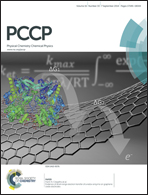Hydrogen interactions with intrinsic point defects in hydrogen permeation barrier of α-Al2O3: a first-principles study
Abstract
It is crucial to understand hydrogen interactions with intrinsic point defects in the hydrogen permeation barrier (HPB) of α-Al2O3, finding underlying reasons for the not-so-low H-permeability of the barrier, and thereby produce samples with tailored defects for optimal performance. Using density functional theory (DFT), the formation energies of intrinsic point defects in an α-Al2O3 lattice, including extrinsic H-related defects (Hi, VAl–H complex, HOi and HO), in all possible charged states, are first calculated under HPB working conditions, to determine the dominant basic defect species for hydrogen. We find that the stable forms of H-related defects in α-Al2O3 are charged H interstitials (Hqi, where q is the charge state of the defect) and hydrogenation of the bulk VAl3− ([VAl3−–H+]q), under hydrogen-rich conditions. As the system reaches equilibrium, H in α-Al2O3 is mainly present in the Hi+ state, and preferentially exists in the form of [VAl3−–H+] and HO+. Migration processes of the dominant defects are further investigated, predicting that Hi+ is the predominant diffusion species in α-Al2O3. [VAl3−–H+]2− and HO+ can release trapped hydrogen during high temperature annealing, contributing to the H-transport in α-Al2O3. The formation energy is much higher than the migration energy for Hi+, suggesting that the migration of Hi+ is the bottleneck for creating low enough H-permeation in α-Al2O3, and corresponding strategies for optimum H-suppressing performance for an α-Al2O3 HPB are proposed.


 Please wait while we load your content...
Please wait while we load your content...